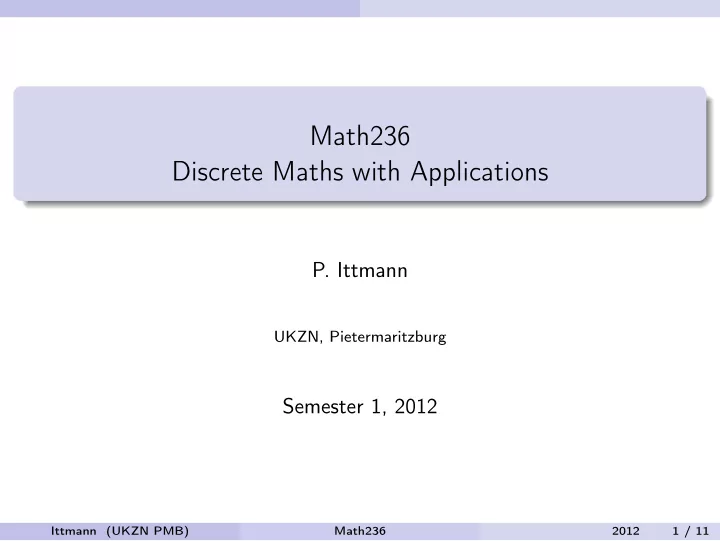

Math236 Discrete Maths with Applications P. Ittmann UKZN, Pietermaritzburg Semester 1, 2012 Ittmann (UKZN PMB) Math236 2012 1 / 11
Weighted leaf paths Definition Let T be a rooted tree with root vertex r Let v 1 , v 2 , . . . , v p be the leaf vertices of T Respectively, let w 1 , w 2 , . . . , w p be the weights of the leaf vertices The weighted leaf path length of T is p � L ( T ) = w i · d ( r , v i ) i = 1 Ittmann (UKZN PMB) Math236 2012 2 / 11
Optimal trees Definition A rooted binary tree T is a optimal if L ( T ) is less than L ( S ) for all rooted binary trees S with the same set of leaf vertices and leaf weights Ittmann (UKZN PMB) Math236 2012 3 / 11
Optimal trees Theorem Let T be a rooted binary tree which is optimal Let v i and v j be leaf vertices of T such that w i < w j Then d ( r , v j ) ≤ d ( r , v i ) Ittmann (UKZN PMB) Math236 2012 4 / 11
Optimal trees Theorem In an optimal tree, if v 1 , v 2 , . . . , v p are leaf vertices with weights w 1 ≤ w 2 ≤ · · · ≤ w p , then d ( r , v p ) ≤ d ( r , v p − 1 ) ≤ · · · ≤ d ( r , v 1 ) Ittmann (UKZN PMB) Math236 2012 5 / 11
Optimal trees Theorem Every Huffman tree is optimal Ittmann (UKZN PMB) Math236 2012 6 / 11
Optimal trees Proof. Suppose to the contrary that some Huffman tree T with root r is not optimal Let v 1 , v 2 , . . . , v p be the leaf vertices of T with weights w 1 , w 2 , . . . , w p where the weights represent the frequencies of the associated character Let w 1 ≤ w 2 ≤ · · · ≤ w p Then there exists i < j such that d ( r , v i ) < d ( r , v j ) Ittmann (UKZN PMB) Math236 2012 7 / 11
Optimal trees Proof. Note that i < j implies that w i ≤ w j If w i = w j , then we can interchange the labels of vertices v i and v j This makes T comply with the definition of optimality Suppose now that w i < w j Ittmann (UKZN PMB) Math236 2012 8 / 11
Optimal trees Proof. Note that d ( r , v i ) < d ( r , v j ) implies that v j is in a level “below” the level of v i This means that in the course of the algorithm which built T , v j was added to a tree S when both v i and v j were isolated vertices Let S ′ be the subtree with root r ′ formed by combining S and v j Let S ′′ be the subtree with root r ′′ formed by combining S and v i Now the frequency associated with r ′ is greater than the frequency associated with r ′′ Ittmann (UKZN PMB) Math236 2012 9 / 11
Optimal trees Proof. This contradicts the rule used in construction of Huffman trees regarding the minimality of a root’s frequency Hence, the result follows Ittmann (UKZN PMB) Math236 2012 10 / 11
Optimal trees We make the observation that some non-Huffman trees are optimal Consider the following trees: 3 T: H: 1 3 2 2 2 1 2 Now, L ( T ) = 16 and L ( H ) = 16 Both T and H are optimal, since H is a Huffman tree However, not every Huffman tree is optimal Ittmann (UKZN PMB) Math236 2012 11 / 11
Recommend
More recommend